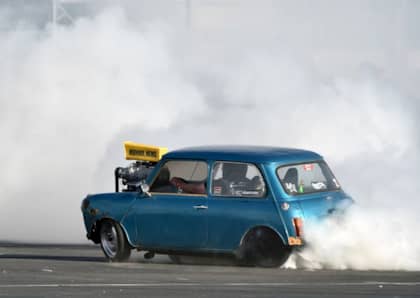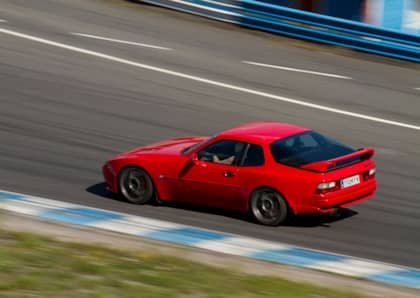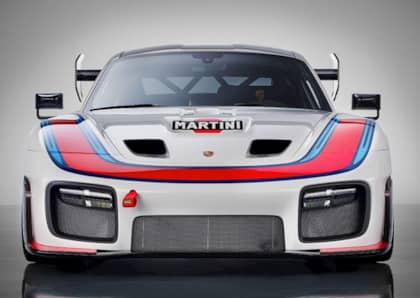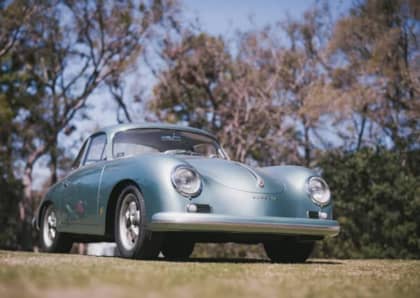1970-1976 Porsche 914: The Most-Maligned Classic P-Car Is Still Worth a Look
Although prices on everything from early 911s to clean 928s seem to be climbing inexorably into the stratosphere, there are still a few stealth bargains lurking in the classic Porsche world. In fact, one of the most misunderstood P-cars is currently the least expensive entry point into pre-'80s Porsche ownership.
You'll have to most fast, however, because the Porsche 914 is also undergoing a reputation rehab that has put it in the sights of collectors, performance fans and German auto enthusiasts alike. Once maligned, now at the very least grudgingly respected, this pint-size roadster represents an interesting chapter in the history of a company that wasn't quite sure how to reach the mainstream.
Smaller, Cheaper, Fun
Nowadays, the idea of a budget Porsche seems like a slam dunk. After all, the Boxster (and later, the Cayman) successfully boiled the balance and precision embodied by the brand's engineering chops down to a smaller and more affordable package that in some ways even outshone the flagship 911.

Nearly 40 years before the first Boxster hit the streets, however, Porsche was struggling to put together a car along almost exactly the same lines: lightweight, low-cost and with an amidships engine layout. One of the primary issues was resources, as the company couldn't invest enough cash into the project to fully develop it in-house, let alone finance its production.
Enter Volkswagen. Seeking a sports car of its own, an agreement was worked out in which Porsche would do the heavy lifting in terms of chassis design and styling, and VW would supply an engine and space on the factory floor, all under the Volkswagen badge. It would give Porsche a much-needed cash infusion, and also allowed it to market a version of the car itself using an in-house engine, if desired.
Work on the car proceeded in partnership in the late 1960s, only to be derailed at nearly the 11th hour when its original champion, VW boss Heinz Nordhoff, chose precisely the wrong moment to pass away. It was here that the gentleman's agreement between Ferry Porsche and Nordhoff was torn asunder by Volkswagen's new leadership, which wasn't pleased that a contract-free deal that saw VW shouldering most of the vehicle's development costs would eventually lead to a "free" sports car for Porsche.
Compromised by Compromise
It's here that the tale of the Porsche 914 takes the dramatic turn that would haunt it for the rest of its days. With both sides unwilling to give up ownership of the vehicle, it was decided that it would be sold as the VW-Porsche in Europe and the Porsche 914 in America. , as the 914 would also proceed globally with the four-cylinder Volkswagen motor that had originally been intended exclusively for VW editions of the car, in addition to a six-cylinder edition.

Compounding the above issues was further political in-fighting about who would pay for what in terms of the vehicle's production costs. Furious about Porsche's seeming lack of skin in the development game, Volkswagen ended up charging the company a much higher price for the bodies and chassis built by its Karmann subsidiary. This pushed the cost of a fully-decked out 914-6 to near-911 levels, obliterating the original concept of an affordable Porsche and crippling the car's chances at successfully finding an audience before it even hit dealerships.
Underwhelming from the Start
When the Porsche 914 finally went on sale as a 1970 model, it presented a mixed bag of pros and cons to curious sports car fans. With a sub-2000 pound curb weight it was exceptionally nimble, and it featured an ultra-rigid design for the era despite offering a removable Targa roof panel. Handling was superb with independent suspension at all four corners and a 55/45 rear/front weight distribution providing a bit of a pendulum effect through the corners. It was practical, too, what with a pair of trunks and a road trip-friendly cabin.

A major asterisk to all of the above, unfortunately, was the 914's engine. The four-banger that had been borrowed from the Volkswagen Type 4 sedan was a complete and total slug, pushing a meager 80hp from its 1.7 liters of displacement. This extended the run to 60 mph took an uninspiring 13 seconds and was matched by a five-speed manual transmission that seemed to fight the driver if rapid cog-swaps were requested.
For those with money to spend, the 2.0L six-cylinder version of the 914 stood in stark contrast to its VW-powered sibling. Featuring just under 110hp and almost 120 lb-ft of torque, it cut a whopping five seconds from the 60 mph sprint and added 15 mph to the car's top end. Few would get to sample its wonders due to its staggering price bump that would send would-be buyers elsewhere in the Porsche showroom.
A Work in Progress
Facing enormous consumer apathy, despite winning its class at Le Mans the year it was introduced, the co-parents of the 914 quickly realized the need for damage control. The fast but pricy 914-6 was a disaster, averaging just over 1,500 sales per year, and it was axed by the end of 1972. The four-cylinder car was brought back home for an engine rebuild that would punch it out to 2.0L and increase its rating to 95hp, allowing for a more affordable range-topper (with a fuel-injected 1.7L weakling still available as a base car). It helped noticeably with performance, with a more reasonable 0-60 time of 10 seconds.

Still, these much-needed improvements couldn't overcome the general public's apathy towards the 914. By now convinced that it was being sold a Volkswagen with a Porsche badge (a not inaccurate summary of the roadster's initial form), facing down a second surge in price in 1974 that had more to do with the global economy than profit and then an emissions-mandated power cut in 1976 that dropped even the larger four-cylinder motor to its knees, Americans never latched on to the 914. After selling 120,000 models worldwide in the space of six years, both automakers would quietly terminate their involvement in the 914 project and remove the car from inventory.
Time for a Second Look
How does the Porsche 914 fare today? Divorced from the feeling of being bamboozled by branding, and with the availability of modern modifications intended to overcome the EPA choking restrictions of the original 914 powerplant, the car is much more palatable from a modern perspective.
Removing 100 lbs of diving board bumpers (on the later cars), adding stiffer shocks and swaybars, and installing 914-6 springs can dramatically improve the already-solid handling inherent in any version of the vehicle. Bolt-on exhaust also adds noticeable grunt to the four-cylinder car, and it's possible to see as much as 200hp from a fully-built engine—or more if you end up swapping in a Subaru or small-block Chevy engine in the 914's generous bay.

Even when left completely stock, the Porsche 914 delivers a different experience than comparable American or British sports cars of the day, combining GT comfort with predictable road manners and German build quality. Chances are you won't have time to worry about the Volkswagen parts whizzing beneath the body work as you cut down your favorite slice of two-lane at the wheel of this relatively inexpensive, but ultimately rewarding classic Porsche.
Curious about other historic Porsches? Check out this profile of the ground-breaking 959.











